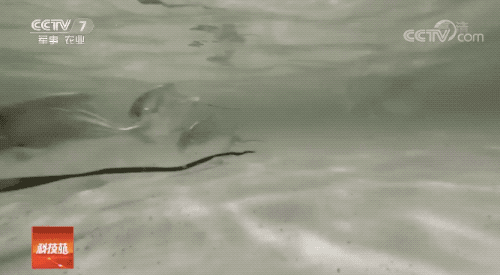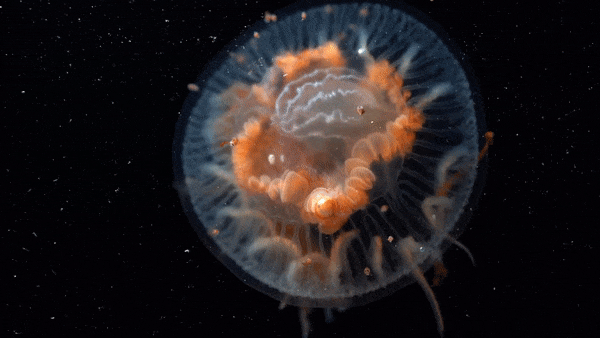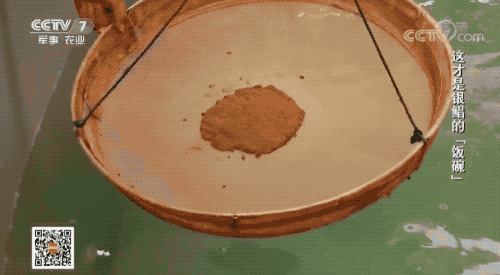You may have eaten this famous seafood, but you have never seen its true face before death!

One of the common fish dishes on the dining table is pomfret. Among all species of pomfret, pomfret (also called Pampus argenteus) is the most delicious. Isn’t there a saying, "There are partridges in the mountains, and horse mackerel in the sea"?

Pampus argenteus Image source: wikimedia
But even if you are a seafood glutton, you may not have seen the real silver pomfret. In fact, even many fishermen don’t know that live silver pomfret actually looks like this: there is a black belt on it.
Why haven’t most people seen the real silver pomfret? Things should start with the fact that silver pomfret is getting more and more expensive.
Silver pomfrets were originally widely distributed in the southeast coast of China and near the Indian Ocean. They are not only the seafood that our people love, but also enjoyed by Koreans, Japanese, Indians and Kuwaitis.

Fried pomfret. Image source: wikimedia
But have you noticed that silver pomfret is becoming more and more expensive and smaller? This is mainly because since the 1990s, the number of silver pomfret in the waters near China has been decreasing year by year.
Not only China, but also other countries that love to eat silver pomfret can’t catch much silver pomfret.
For example, the number of silver pomfret in Indian Ocean waters is also declining. According to the statistics of India’s Central Marine Fisheries Research Institute, the number of silver pomfret along the Indian Ocean coast decreased from 34,072 tons to 27,515 tons in 2011-2012, a drop of 20%.

Image source: wikimedia
Because the price is higher than that of other pomfrets, some vendors will use the less delicious but very cheap pomfret (also known as fighting pomfret, China pomfret, Pampus chinensis) to mix the pomfrets. You may have eaten fake silver pomfret for many years and you don’t know it.

Pampus chinensis is very similar to silver pomfret. Image source: FishBase.se
Will the braised silver pomfret be extinct in the future? Why not raise silver pomfret artificially?
Foodies who don’t want to create a generation gap in food have actually taken action long ago, but countries have not succeeded in half a century.
As early as the 1960s, people began to try to breed silver pomfret artificially, but at that time, silver pomfret fry often died after a few days of incubation. Shi Zhaohong, a researcher at the Donghai Fisheries Research Institute of the Chinese Academy of Fishery Sciences, said that this is why the cultivation of silver pomfret has always been a "world-class" problem, and it is therefore called "the most difficult fish to raise in the world".

Image source: wikimedia
This can also explain why, in 2000, the Mariculture and Fisheries Department of Kuwait Institute for Scientific Research, which achieved a survival rate of 4%, called its achievement a "breakthrough".
So, why is silver pomfret difficult to raise?
The first reason why silver pomfrets are difficult to raise is that their scales are really brittle. Their scales are very small and few, and they will fall off with a little touch. And once they lose their scales, they are easy to die of infection.
Secondly, silver pomfret is still "blx". They are very timid. When the waves are big and the water is salty, when the water is weak, they will scamper and lead to scaling.
When the silver pomfret dies, it will also take away a mysterious organization, that is, the black belt.

There is a black belt on the lower caudal fin of live immature silver pomfret. Image source: See Watermark
In fact, the lower caudal fin of immature silver pomfret is very long and black, sometimes twice as long as the upper caudal fin. Shi Zhaohong said that about half of the caudal fin of silver pomfret will be extended into a black belt, which will fall off after the death of silver pomfret, but researchers are not clear about the role of this black belt at present.
That’s why even fishermen don’t know what live silver pomfret looks like.
The third difficulty in artificial breeding of silver pomfret lies in taking eggs.
To raise silver pomfret artificially, you must first get fish eggs, right? But the wild silver pomfret will die as soon as it comes out of the water, and it won’t give you a chance to keep seeds at all.
So, how about taking "essence" from dead fish?
Shi Zhaohong said that they haven’t tried it before. However, as soon as the wild female silver pomfret struggled out of the water, the eggs were "pulled" into the sea.
Later, researchers in China and Kuwait finally came up with a solution.
At that time, in order to get the sperm and eggs of silver pomfret, researchers in China directly caught fish in seawater, and then artificially inseminated them on the spot when they came out of the water. Around 2000, researchers in Kuwait also got fish eggs from the wild environment.
Getting fish eggs is only a small achievement, because the larvae of silver pomfret are difficult to raise.
Silver pomfret likes to eat live jellyfish and all kinds of jelly-like plankton, and does not eat granular feed. But feeding jellyfish to them will be troublesome and costly.
In 1998, researchers from Kuwait Institute of Science came up with a method called Artemia nauplii. After being fed with shrimp for a period of time, little silver pomfret can adapt to fish feed, and then they switch to fish feed.

Artemia nauplii. Image source: Matthias Wiesensee
At first, Shi Zhaohong and his colleagues used a similar method. They first raised a batch of shrimp and rotifer (Brachionus plicatilis), fed them to small fish, and then turned them into feed.
Despite the reversal from "can’t" to "can", the commercial value of artificial silver pomfret 20 years ago was not clear. In 1998, the survival rate of fry in Kuwait was only about 4%. In 2009, the survival rate of silver pomfret fry of Shi Zhaohong’s team was 14%. Compared with other commercial fish species, this survival rate is really not easy to get.

Image source: wikimedia
But later, Chinese researchers improved the seedling raising technology.
When promoting silver pomfret fry in 2019, Wang Yajun, an associate professor at the College of Oceanography of Ningbo University, said that the survival rate of silver pomfret fry cultivated in China has reached more than 75%, and the number of seedlings has reached more than 200,000. The breeding technology level is leading in the world and the number ranks first in the world.
What method did they use?
It turned out that they used raw seafood to "cook" the silver pomfret fry. They let the jellyfish eat the feed first and turn it into a "Trojan horse", and then feed the jellyfish wrapped in feed to the silver pomfret. From snacks to jellyfish stuffed with feed, silver pomfret can gradually adapt to feed.

Image source: Network
However, even if the silver pomfret learns to eat feed, the problem is only half solved, because the adult silver pomfret really eats badly.
Other commercial fish species can eat feed that floats on the water surface or sinks at the bottom of the water. For example, cheap golden pomfret (Trachinotus blochii) can eat the feed floating on the water at will, so they are easy to raise and cheap.

Trachinotus blochii. Image source: wikimedia
But silver pomfret can’t. Their mouths are not "normal": the upper jaw of silver pomfret can’t move because it is covered with skin, so it can only rely on the lower jaw to open its mouth and shut up.
But their jaws are long, and it’s a long story. In short, it’s a form of heaven and earth. In technical terms, the mouth of silver pomfret is "inferior" and there is no way to eat surface feed.

The upper lip of the silver pomfret can’t move (source: FishBase.se)
Well, then you can always eat underwater feed, right?
Silver pomfret doesn’t eat either.
Of course, this can’t be blamed on silver pomfrets, because their bodies are flat and flat, and they have to swim all the time to avoid rollover. If you eat enough in one breath, you may lie flat on the bottom of the sea and scratch your scales and die. That’s why they don’t touch the bottom feed.
Because of its mouth and flat body, the silver pomfret can only eat food in the water, and it has to run after two bites, and then come back to eat after a while, much like you were chased to feed when you were a child.
But it is in the face of such a difficult silver pomfret that researchers have recently found a way to raise it artificially on a large scale.
The above-mentioned Shi Zhaohong team spent 20 years designing a special dining table and residence for the silver pomfret.

A feed net specially used for feeding adult silver pomfret. Image source: See Watermark
The silver pomfret dining table they designed is "suspended", which is very friendly to the mouth of the exotic silver pomfret, and the feed will not fall to the bottom to pollute the water quality; The farm is a medium-sized artificial seawater breeding pond.
Seeing that the silver pomfret has finally been fed by human beings, everyone must have shed saliva of relief. I hope that China’s breeding methods can be popularized as soon as possible, so that this delicious food will not be lost.
Plan and make
Original title: "You may have eaten this famous seafood, but you have never seen its true face before death! 》
Read the original text